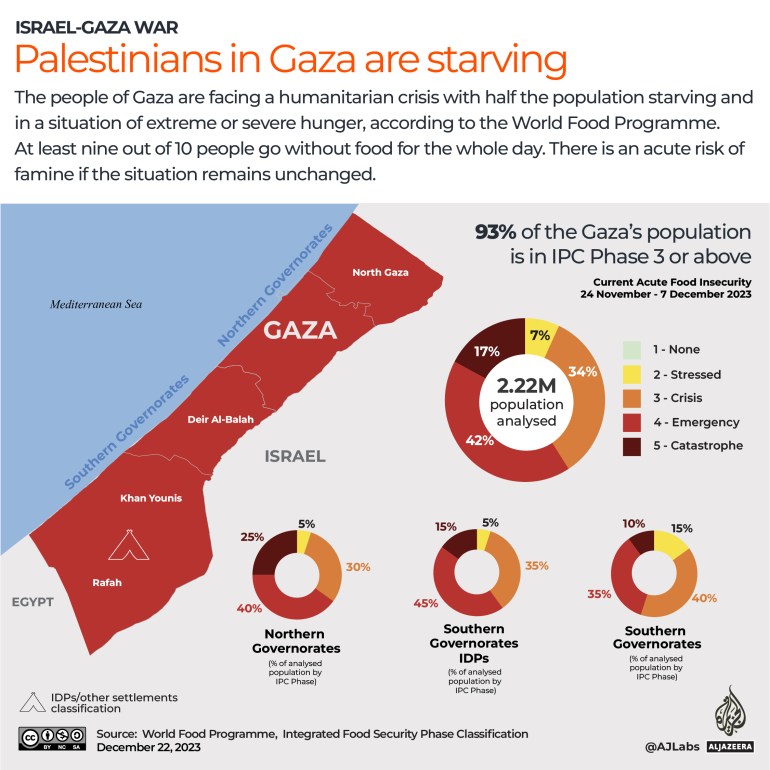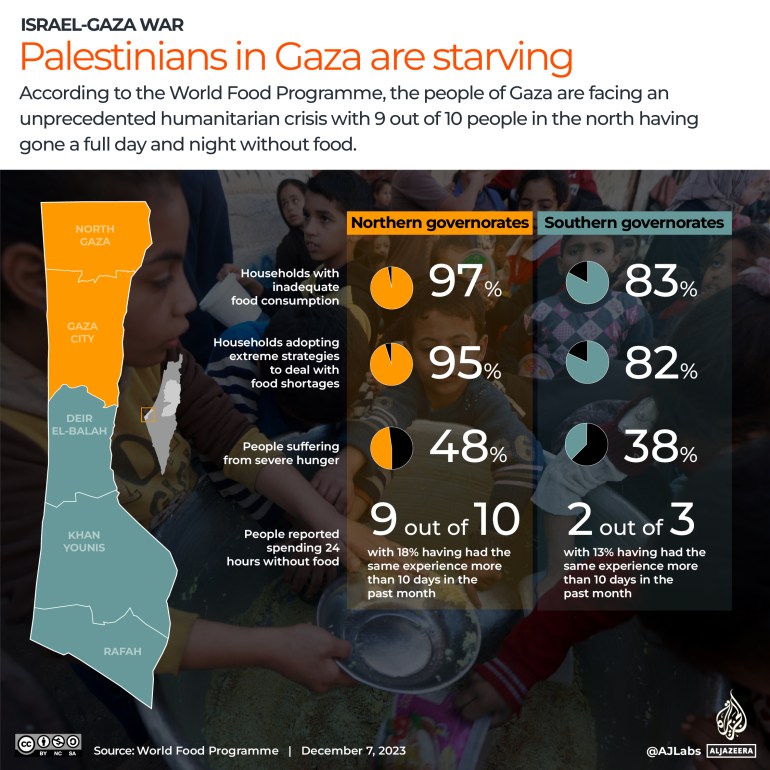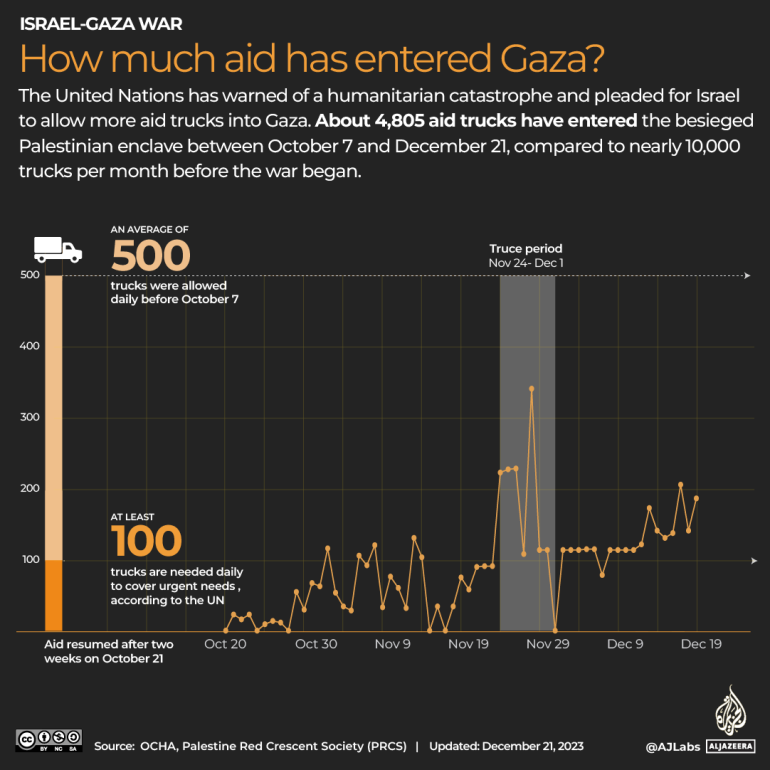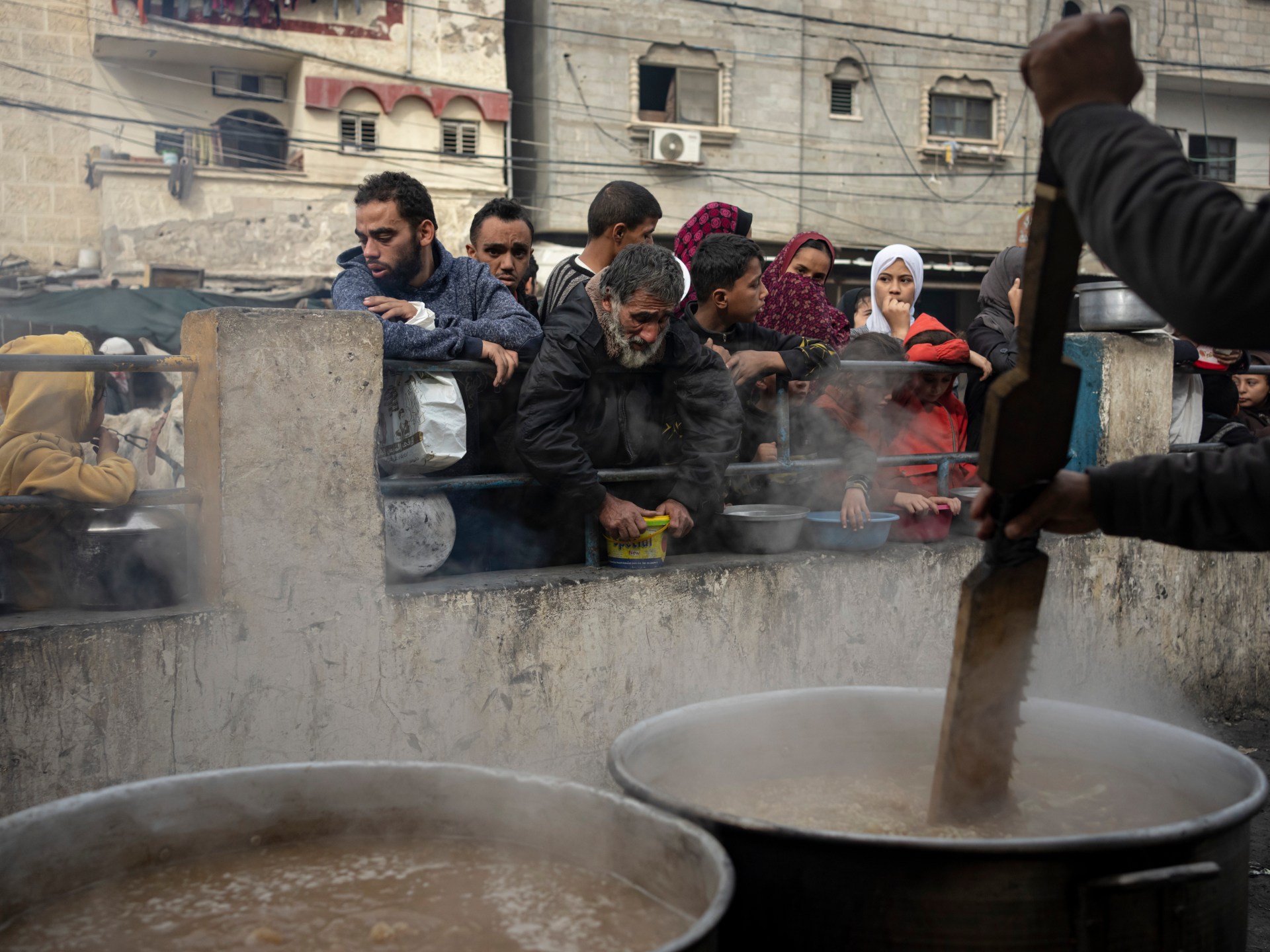Weeks of restricted access to food in the Gaza Strip have culminated in severe hunger and growing risks of famine in the besieged enclave.
Since early October, Israeli attacks across Gaza have damaged local bakeries and food warehouses, along with roads that are used to transport humanitarian aid. Israel’s total blockade on the enclave has also restricted food, water and fuel from entering in the first place.
How bad is starvation in Gaza and what is the food supply like since the war? Here is what we know.
What does the IPC report say about Gaza?
More than 90 percent of Gaza’s 2.3 million population is facing high levels of acute food insecurity, according to an Integrated Food Security Phase Classification (IPC) report on Monday.
The IPC, which measures hunger risks, also reported on Thursday that 2.08 million people in Gaza are facing “acute food insecurity” that can be classified in the organisation’s phase three of risk or above.
The IPC has five phases of acute food insecurity, ranging from none (phase one) to catastrophe or famine (phase five). Phase three and five are considered crisis and emergency. “Acute” food insecurity is a short-term phenomenon and tends to stem from unusual or man-made shocks, compared with “chronic” food insecurity, which is long term and a result of insufficient means for living.
Between December and February, Gaza’s entire population is projected to fall under phase three or above, according to the United Nations-backed report.
If current hostilities and limited aid continue, Gaza is also at risk of experiencing a famine by early February. The IPC definition of famine is when at least 20 percent of the population in an area falls under phase five of acute food insecurity.

What does food access look like in Gaza?
Families in Gaza have had to cope with deteriorating quality and declining quantities of food, along with an inability to cook meals due to fuel shortages.
Spending a day without eating any food has become usual. In early December, the World Food Programme (WFP) reported that nine out of 10 people across the enclave skip meals for long periods.
Nutritionally vulnerable groups such as pregnant women are at heightened risk, while baby formula and milk have been in severely short supply for toddlers who rely on it.
Even preparing meals requires finding alternatives to cooking gas, and aside from using firewood or cardboard, at least 13 percent of displaced people have been forced to burn solid waste, says the WFP.
Hunger has also quickly escalated since a brief truce ended in early December. Just 12 days after it ended, the WFP found that at least half of internally displaced people surveyed knew someone who had resorted to consuming raw meat.
Access to water is also scarce, with less than two litres (0.5 gallons) available for each person per day – far short of the 15 litres needed to survive, according to the WFP.

What level of food aid is entering Gaza?
Since October 7, the number of trucks carrying food that entered Gaza in a month fell by more than half, compared with at least 10,000 trucks before the war.
Over two months of war, only 1,249 trucks carrying food assistance reached Gaza, the WFP reported on December 6. The UN Office for the Coordination of Humanitarian Affairs also reported that over the first 70 days of the war, only 10 percent of the food needed for Gaza’s entire population entered the enclave.
The WFP has recommended that at least 100 trucks carrying just food and water enter Gaza a day, but on most days since the war even the total amount of trucks entering has been less than that. The agency also noted that damaged roads near Rafah at the border with Egypt – where must aid is now dispersed from – cannot accommodate this increase.
At the height of aid supply during the truce lasting from November 24 to December 1, some 200 trucks entered daily, while the WFP was only able to reach about 10 percent of Gaza’s population with in-kind and cash-based food assistance.
Even once food aid is supplied, access to a sufficient share has not been possible. A report from the Palestinian Centre for Human Rights (PCHR) and Al Mezan, a human rights organisation based in Gaza’s Jabalia refugee camp, on December 14 found that people near Rafah’s food distribution centres would often have to wait in line for 10 hours, and sometimes still returned home empty-handed.
“I have to walk three kilometres to get one gallon [of water],” Marwan, a 30-year-old Palestinian, who fled south with his pregnant wife and two children on November 9, told Human Rights Watch. “And there is no food. If we are able to find food, it is canned food. Not all of us are eating well.”
Still, Gaza’s population primarily relies on humanitarian assistance for food, followed by local markets and assistance from friends or relatives. With rising shortages across all of these, support from relatives is also dwindling, according to the WFP.
As more of Gaza’s population is pushed into shelters in southern governorates, which are also under intense bombardment, competition for food is expected to increase, said the IPC.

Can people in Gaza access food locally?
Fighting across the Gaza Strip, and especially in the northern governorates, has particularly made it difficult to access food and aid.
Local farmlands, flour mills, bakeries and warehouses have also been directly damaged by Israeli bombardments.
Only a month after fighting broke out, all of northern Gaza’s bakeries closed due to lack of supplies such as flour and fuel, the UN reported on November 8. Risks of being hit by Israeli strikes also resulted in movement restrictions for those seeking to leave their homes for food.
Sumber: www.aljazeera.com
 Skip to content
Skip to content

